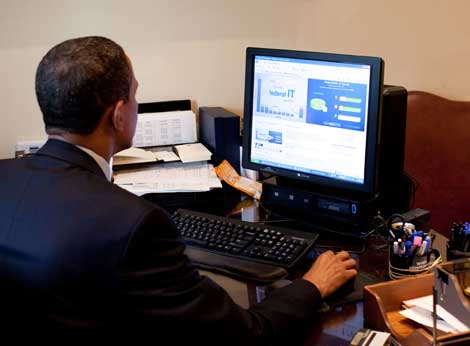
President Barack Obama test-driving the IT Dashboard for the U.S. government, which tracks the progress of federal IT projects and the spending associated with them. (Photo: The White House)
The "single pane of glass" is the holy grail of IT management, a single screen that can provide a consolidated view of an organization's management. But can a good dashboard really have a huge impact on an organizations IT operations.
Vivek Kundra says that it can - if you have the right person looking at that dashboard. Kundra, who was the U.S. government's first CIO, made the development of the Federal IT Dashboard one of his first priorities. In an early meeting with Congress, Kundra promised that his team would build a dashboard within 60 days.
That's when his staff started to get nervous. "They said 'don't you know nothing gets done in 60 days in the federal government?" Kundra recalled in his recent keynote at AFCOM Data Center World. That was the attitude Kundra intended to change, starting with the new dashboard, which went live on schedule on June 1, 2009.
The IT dashboard displays data received from agency reports on $80 billion in spending on more than 7,000 IT investments, including detailed data for over 700 of those investments that agencies classify as "major." Agency Chief Information Officers (CIO) are responsible for evaluating and updating the data on a regular basis. If a project is behind schedule or over budget - which was the case with $27 billion in IT spend - the dashboard displays the details along with a picture of the person responsible for the project.
That was a vivid way to get the attention of agency CIOs. The next step: A photo of President Barack Obama using the dashboard.
"The fact that the president was looking at the IT dashboard made such a difference," said Kundra. "You started to see the results of shedding light on how government as spending its IT money. That led to the creation of accountability sessions." Those efforts used TechStat, a tool developed to prepare and document a plan to get troubled projects back on track.
That harshest light shone on troubled projects. An example: The Department of Justice had spent 10 years and nearly $1 billion developing an enterprise resource planning (ERP) system that wasn't working. The project was cancelled, Kundra said, along with three other of the government's 40 largest projects. The government reduced the scope of 11 other struggling projects. The combined savings from the terminated and downsized projects was about $3 billion.
"The old model was that a project would only be cancelled if it became a headline in the New York Times or Washington Post," said Kundra.
In March 2011 the code for the government dashboard was released to the public as open source software, and is available on SourceForge.




